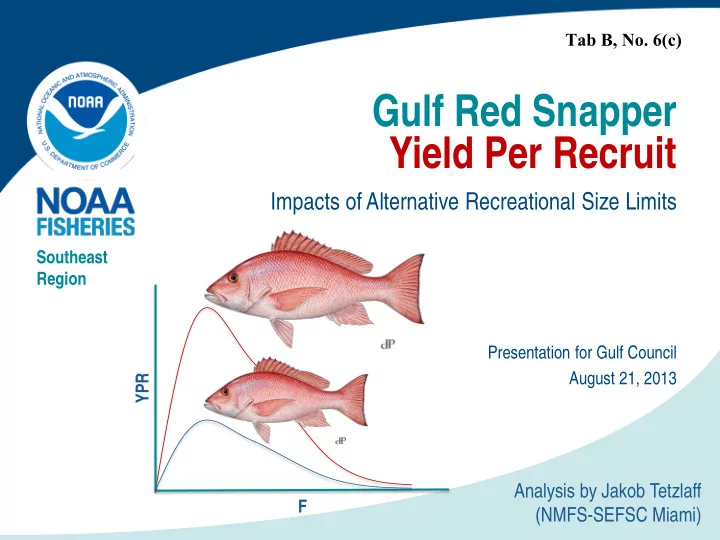

Tab B, No. 6(c) Gulf Red Snapper Yield Per Recruit Impacts of Alternative Recreational Size Limits Southeast Region Presentation for Gulf Council YPR August 21, 2013 Analysis by Jakob Tetzlaff F (NMFS-SEFSC Miami)
What is Yield Per Recruit (YPR)? Maximizing effort does not maximize yield • There is an optimum fishing rate that maximizes yield. • YPR estimates yield in terms of weight for a fixed number of individuals entering the fishery (i.e., recruits) based on various combinations of natural mortality, fishing mortality, and selectivity/retention (i.e., size limits) YPR models include: 1. Number of recruits Yield per Recruit SSB per Recruit 2. Growth rate 3. Natural mortality rate Selection pattern in the fishery 4. alternative size limits Overall fishing mortality includes 5. other sectors F U.S. Department of Commerce | National Oceanic and Atmospheric Administration | NOAA Fisheries | Page 2
Why is YPR important for regional management? Although red snapper may be managed separately by each Gulf state, it is one unit stock • Different size limits in different states may be desired impact YPR • A39 allows regions to set size limits ranging from 14-18” TL Gulf-wide YPR potential realized YPR YPR YPR YPR YPR YPR + + + + = F F F F F F U.S. Department of Commerce | National Oceanic and Atmospheric Administration | NOAA Fisheries | Page 3
YPR for Gulf Red Snapper Implemented in Stock Synthesis 3 (SS3: SEDAR-31 Base Model) • All base model input parameters held constant: • Commercial fishing mortality/selectivity/retention • Recreational selectivity • Shrimp fleet bycatch • Recruitment • Growth function • Recreational release mortality = 10% East & West • Etc. • Evaluated YPR for different recreational size limits by altering SS3 retention patterns in most recent year • Evaluated size limits from 10 – 24 inches TL U.S. Department of Commerce | National Oceanic and Atmospheric Administration | NOAA Fisheries | Page 4
Yield per Recruit at different recreational size limits Maximum YPR at 15” • YPR relatively flat between 12” and 18” • SPR increases with size limits • U.S. Department of Commerce | National Oceanic and Atmospheric Administration | NOAA Fisheries | Page 5
Projected landings at different recreational size limits • Gulf-wide landed biomass maximized at a recreational size limit of 15”, although relatively constant between 12” and 18” • Increasing the size limit for the recreational fishery decreases the projected number of fish caught since landed fish will be bigger U.S. Department of Commerce | National Oceanic and Atmospheric Administration | NOAA Fisheries | Page 6
YPR for Gulf Red Snapper • Given current state of stock and selectivity patterns of fisheries, size limits 13“-18" appear effective (<1% difference) • 15” optimal to maximize landings (lbs) • Changes in the state of the stock or selectivity patterns of the fisheries would lead to alternative optimal size limits U.S. Department of Commerce | National Oceanic and Atmospheric Administration | NOAA Fisheries | Page 7
U.S. Department of Commerce | National Oceanic and Atmospheric Administration | NOAA Fisheries | Page 8
Recommend
More recommend